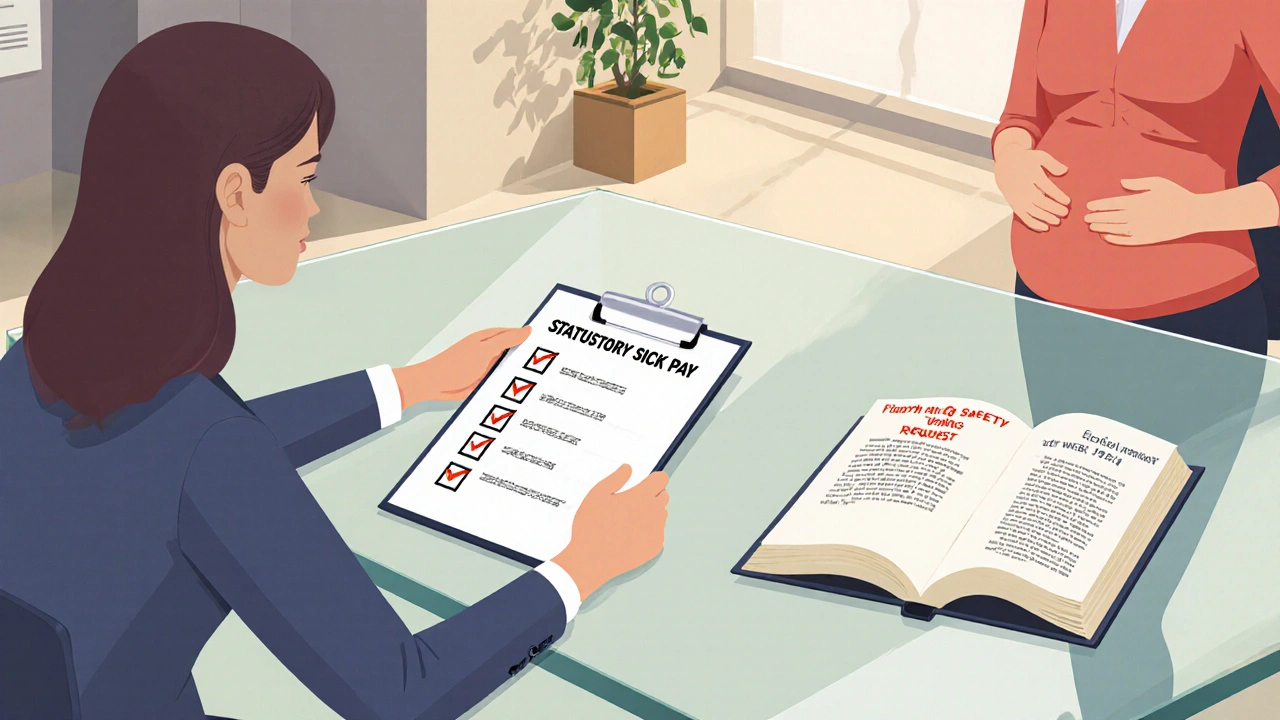Pregnancy Nausea Symptom Checker
Assess Your Symptoms
Answer the following questions to determine the severity of your pregnancy-related nausea and get personalized recommendations:
Your Symptom Analysis
Desk-Friendly Remedies
Here are effective, workplace-appropriate remedies to manage nausea:
Ginger
Anti-inflammatory compounds soothe the stomach lining. Try ginger tea or capsules.
Peppermint
Menthol relaxes gastrointestinal muscles. Use tea or essential oil on a cotton ball.
Acupressure Bands
Apply pressure to the P6 point to reduce nausea signals. Wear discreetly.
Hydration
Drink clear fluids regularly. Ice chips, herbal teas, or diluted fruit juices work well.
When vomiting during pregnancy occurs while you’re on the job, it can feel like a double‑whammy: the physical discomfort plus the pressure to stay professional. You’re not alone-many expectant employees face the same challenge, especially during the first trimester when morning sickness peaks. This guide walks you through what’s happening in your body, what your workplace must legally provide, and hands‑on tricks you can use today to keep the nausea under control.
What’s Behind Pregnancy‑Related Vomiting?
First, let’s demystify the symptom. Morning sickness is a common term for nausea and vomiting that affects up to 80% of pregnant people, typically between weeks 6 and 12. It’s driven by hormonal shifts-especially higher levels of human chorionic gonadotropin (hCG) and estrogen-that upset the stomach’s normal rhythm. In a minority of cases, the condition escalates into hyperemesis gravidarum a severe form of vomiting that can lead to dehydration and weight loss. Knowing whether you’re dealing with regular nausea or a more serious episode helps you decide when to try self‑care and when to call a doctor.
Know Your Legal Rights in the UK Workplace
British employment law protects you when health issues interfere with work. Your employer has a duty to provide a safe and healthy working environment under the Health and Safety at Work Act 1974. This includes making reasonable adjustments for pregnancy‑related conditions. Here’s what you can expect:
- Statutory Sick Pay (SSP): If vomiting forces you to stay home, you’re eligible for SSP after four consecutive days of sickness, provided you meet the earnings threshold.
- Flexible working request: After 26 weeks of pregnancy, you can formally ask for flexible hours or remote work. Even earlier, many HR departments are open to informal arrangements.
- Risk assessments: Your employer should assess any workplace hazards that could worsen nausea, such as strong odors or intense physical activity.
Don’t hesitate to speak to HR or a trusted manager. Having a brief note from your midwife or GP can streamline the conversation and make the process smoother.

Workplace Strategies You Can Implement Today
Small changes can make a big difference. Try these practical steps during a typical workday:
- Plan short, frequent breaks: Instead of a single lunch break, schedule 5‑minute pauses every hour to sip water or eat a light snack.
- Choose a well‑ventilated spot: If you can, set up near a window or a fan to disperse lingering food smells.
- Keep a stash of bland crackers or dry toast at your desk; an empty stomach often triggers nausea.
- Stay hydrated: Aim for at least 1.5 liters of clear fluids throughout the day. Ice chips, herbal teas, or diluted fruit juices work well.
- Use discreet positioning: If possible, keep a small bag of anti‑nausea wipes or a scented handkerchief (e.g., lemon) nearby for quick relief.
Remember, you don’t have to explain each break in detail-simply let your manager know you’re managing a temporary health condition.
Desk‑Friendly Remedies to Tame Nausea
Natural options are low‑risk and easy to keep at a workstation. Below is a quick comparison of four popular remedies.
| Remedy | How it works | Typical dosage | Potential side‑effects |
|---|---|---|---|
| Ginger | Anti‑inflammatory compounds soothe the stomach lining | 1‑2 teaspoons of ginger tea or 500mg ginger capsules | Rare heartburn if consumed in large amounts |
| Peppermint | Menthol relaxes gastrointestinal smooth muscle | 1 cup of peppermint tea or a few drops of peppermint oil on a cotton ball | May worsen acid reflux in some people |
| Acupressure wrist bands | Pressure on the P6 (Neiguan) point reduces nausea signals | Wear continuously while at work, adjusting for comfort | Skin irritation if band is too tight |
| Antiemetic medication | Blocks neurotransmitters that trigger vomiting | Prescribed dose (e.g., 10mg ondansetron once daily) | Possible drowsiness; requires doctor’s prescription |
Most people find that ginger tea and acupressure bands work well together. Keep a small thermos of ginger tea in the office kitchen and a discreet wrist band at hand.

When to Seek Professional Medical Help
If nausea turns into constant vomiting, you might be experiencing hyperemesis gravidarum. Warning signs include:
- Inability to keep any food or fluid down for 24hours
- Weight loss exceeding 5% of pre‑pregnancy weight
- Signs of dehydration: dark urine, dizziness, rapid heartbeat
Contact your GP or midwife promptly. They may prescribe anti‑emetic medication or recommend IV fluids. Early intervention can prevent complications and reduce time off work.
Daily Coping Checklist
Print this out or keep it on your phone to stay on track:
- ☑️ Pack ginger tea bags or a ginger capsule before leaving home.
- ☑️ Bring a small snack (crackers, banana) for mid‑morning.
- ☑️ Set an hourly reminder to drink a glass of water.
- ☑️ Position your workstation near a vent or window.
- ☑️ Keep an acupressure wrist band handy.
- ☑️ Inform your manager of a flexible break schedule.
- ☑️ Have a note from your healthcare provider ready in case you need SSP.
Adjust the list as you discover what works best for you. Small wins add up, and you’ll notice fewer “oops” moments throughout the day.
Frequently Asked Questions
Can I claim Statutory Sick Pay for nausea alone?
Yes, if vomiting prevents you from performing your duties for four consecutive days, you qualify for SSP. You’ll need a medical note confirming the condition.
Is it legal for my boss to ask for a pregnancy‑related medical certificate?
Employers can request evidence if they need to assess reasonable adjustments or confirm eligibility for sick pay. A brief note from your midwife or GP is sufficient.
Do anti‑emetic pills affect my baby?
Most anti‑emetics prescribed during pregnancy, like ondansetron, have been studied and are considered safe when used under medical supervision. Always discuss dosage with your doctor.
Can I work from home while dealing with morning sickness?
If your role permits remote work, you can request a temporary work‑from‑home arrangement. Highlight productivity benefits-fewer breaks for bathroom trips and a calmer environment.
What should I do if I feel faint at my desk?
Sit or lie down immediately, elevate your legs, and sip water. If faintness persists, ask a colleague to help you get to a safe area and consider contacting your healthcare provider.

17 Comments
richard king
Pregnancy turns the office into a battlefield where the stomach fires its own artillery. The hormones act like rogue generals, marching the digestive system into chaos. When the inevitable wave hits, the world seems to tilt, and the only weapon left is a steady breath. Yet, within that turbulence lies a quiet reminder of new life taking hold. Embrace the storm, and you’ll discover a resilience you never knew you possessed.
William Lawrence
Oh great because what every pregnant professional really wants is a personal vomit alarm
Grace Shaw
The prevalence of nausea and vomiting in early gestation is a well‑documented obstetric phenomenon, affecting approximately eighty percent of pregnant individuals. This physiological response is primarily mediated by the rapid rise of human chorionic gonadotropin and estrogen, which alter gastrointestinal motility. Consequently, the gastric lining becomes hyper‑sensitive to both mechanical and chemical stimuli. In the occupational setting, such hyper‑sensitivity can compromise both productivity and professional demeanor. The United Kingdom’s Health and Safety at Work Act of 1974 imposes a statutory duty on employers to ensure a safe working environment, which extends to pregnancy‑related conditions. Employers are therefore obligated to perform risk assessments that identify and mitigate hazards such as strong odours, inadequate ventilation, and excessive physical exertion. Reasonable adjustments may include flexible working hours, remote work options, or the provision of a quiet, well‑ventilated workstation. Statutory Sick Pay becomes applicable after four consecutive days of incapacity, provided that a medical practitioner confirms the inability to perform duties due to vomiting. A formal note from a midwife or general practitioner serves as sufficient evidence for both sick pay eligibility and the initiation of workplace accommodations. From a clinical perspective, the distinction between ordinary morning sickness and hyperemesis gravidarum hinges upon factors such as sustained weight loss, dehydration, and electrolyte imbalance. Patients presenting with the latter condition often require intravenous fluid therapy and prescription anti‑emetic medication under medical supervision. Early intervention not only reduces maternal morbidity but also limits unnecessary work absenteeism. Practical, desk‑friendly remedies-such as ginger tea, peppermint oil, and acupressure wrist bands-have demonstrated efficacy in attenuating nausea without compromising occupational responsibilities. Implementing short, frequent hydration breaks and maintaining a supply of bland carbohydrates can further stabilise gastric activity throughout the workday. Ultimately, a collaborative approach between the employee, healthcare provider, and employer fosters an environment where both fetal development and professional obligations can be upheld safely.
Sean Powell
Yo man, I get it-nausea feels like an unwanted coworker, but grab a ginger tea stash n a discreet wrist band and you’ll keep the drama low key.
Henry Clay
If you’re not taking your health seriously enough to ask for the adjustments you deserve then you’re simply putting the unborn child at risk :)
Isha Khullar
The body’s rebellion against a new life feels like a tempest, yet inside that storm lies the promisse of tomorrow.
Lila Tyas
Hey there! 🌟 You’ve got this-keep that ginger tea on the desk, sip water like it’s your secret superpower, and remember every tiny step brings you closer to meeting your little one!
Mark Szwarc
A quick note: when you write ‘hydratation’ remember the correct spelling is ‘hydration’; also, ‘anti‑emetic’ should be hyphenated. Small edits like these keep your workplace documentation crisp.
BLAKE LUND
In many cultures a warm cup of ginger tea is more than a remedy-it’s a ritual that signals care and community, making it a perfect low‑key ally at your desk.
Veronica Rodriguez
Pro tip: keep a small bag of crackers in a drawer; when nausea hits, a bite can settle the stomach fast 😊.
Holly Hayes
One mustn’t overlook the epistemological nuances of gestational queasiness; it is, after all, a sophisticated physiological tableau, not merely a ‘tummy upset’ as some might colloquially pharse.
Matthew Shapiro
Just a reminder: “SSP” stands for Statutory Sick Pay, and it’s only payable after the requisite four‑day waiting period, so plan your leave accordingly.
Julia Phillips
Imagine a foggy London morning, the rain pattering against the window, and you clutch a peppermint sachet like a talisman-suddenly the nausea recedes, and the world feels a shade brighter.
Richa Punyani
Dear colleague, please ensure that you schedule hourly hydration reminders and keep a discreet ginger sachet within reach; such proactive measures are both professionally prudent and personally comforting.
John Price Hannah
Listen up!!! The office is not a battlefield, but your belly is waging war!!! Grab that ginger tea, slam down those crackers, and let the acupressure band scream silence to the nausea!!! Do NOT let a bout of vomiting dictate your career trajectory!!! Your future child counts on you staying resilient, so stand tall, hydrate like a champion, and command your workspace with unstoppable vigor!!!
Echo Rosales
Honestly, taking the whole ‘flexible hours’ thing is just an excuse to slack off.
Elle McNair
Let’s all remember to be kind to ourselves and each other; a little understanding goes a long way.